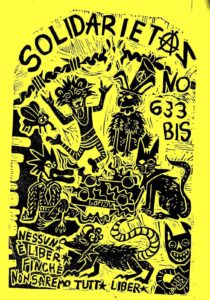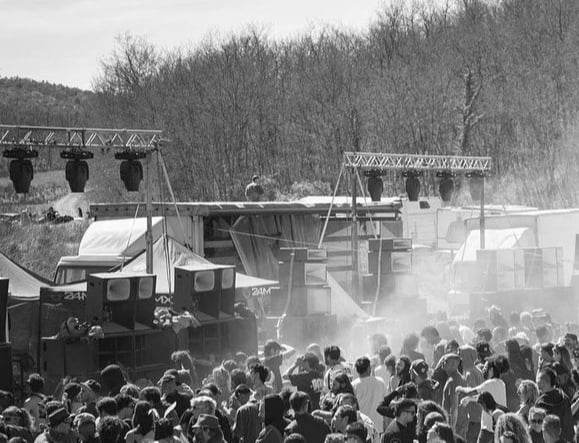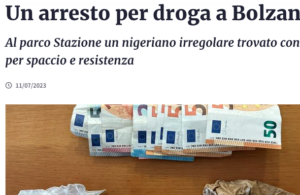




Here's the translation of the 1st part of this article in ITA
—
ITALIAN CRACKDOWN; FROM THE "ANTI_RAVE" LAW TO DEMONIZING NARCOTICS DRIVING AS CONTROL SYSTEM
(2k23 – Autumn)
With the advent of the Meloni government and acolytes at the Palazzo Chigi, we "witnessed" as the first reactionary show the sad and boorish hyper-spectacularity by the media on the "Whichtek" in Modena, which paved the way for the introduction of the "Anti-Rave" bill; this, after some discontent about the unconstitutionality of the package, became law in late 2022. The target, which initially seemed to strike at any form of unauthorized gathering due to issues of "public safety," is clear: the demonization of otherness and the non-subordination of forms of expression that do not conform to the directives of power, both state and local, and that cannot be convertible on business. Nonetheless, when it comes to contexts such as "raves" and "freeparties," the emphasis on public "safety" and public "decorum" often falls on the freedom of movement and use of illicit substances, dynamics therefore subject to sanctions, prosecutable and punishable.
The degree of oppression that the state in its forms of representation applies from time to time descends not so much from the presumed harmfulness of consumption and its forms of distribution, but from the socio-cultural context and forms of consensus that are shaped by and for the public opinion. We found ourselves after the Ferragosto rave of 2021 in Valentano (“Space Travel Vol. II) in front of a frightening media distortion, and a full-scale demonization that was followed by various measures aimed at tightening the ranks of repression against these gatherings, with press announcements about "inter-force anti-rave coordination" between prefects and regional police headquarters, police interventions (Tuscany, Sicily, Emilia-Romagna, Salento, and so on), thousands of expultion orders issued on the occasion of several free-parties, threats of application of devices such as special surveillance to some members of the crews that have carried on the practice of reappropriating unused spaces for generations.
Nonetheless, for the past two years, the doggedness of not only the right-wing press has led to inflating the term "rave" to all those forms of youth diversion reducible to a problem, or supposedly so, of public order: thus in the whirling process that instills a perception different from the previously given terminological meaning, it has become rave to bivouac in a park as much as to listen to music from a cell phone in squares while drinking two beers, even to unauthorized karaokes in clubs.
It is through this alarmist and nasrity atmosphere that the anti-rave decree was imposed. It is important to place this event well within the cultural digression and the progressive narrowing of the freedoms of expression and demonstration within the country and more generally in the "Fortress Europe": only between ten and fifteen years ago the squares of the main urban centers were usable spaces for people to stop and interchange without hourly restrictions, now they are almost constantly traversed more by patrols- not infrequently by the military-than by people, to give an example. In this context, the anti-rave decree, which demonizes an already illegal and anti-authoritarian mode of encounter and expression, is the crystallization of the social thermometer regarding spontaneous forms of alterity and conscious insubordination, the result of an over-decade-long process.
The 'otherness passes, undoubtedly, also from the freedom of individual and collective intake and experimentation with substances, the illegality of which is dictated not only by the tightening of penalties and intensification of the police hand, as much as a fairly significant extent by the installation of the phobic climate and the perception of danger for the individual owner in the territories in which he lives.
Isn't this the same delatory mechanism also seen during the Covid restrictions? now is full-filled by the neighborhood-wa apps and the constant warnings against young people spending their… youthfulness (!) deprived of the last remaining 'public' spaces, in any case already restricted and stifled? Here is where the 'rave,' its nonconformity and its becoming temporary public space through modes of de-privatization, becomes a monster. The techniques of repression and control to these forms also determine the degree of social regimentation, and the refinement of extensible and adaptable securitarian measures. And they feed on the extra-mediatization of such complex and contradictory phenomena as drug dealing and consumption.
It is no coincidence that we have seen, with the Meloni – Piantedosi settlement, increasingly tightened propaganda against micro-crimes, with sweeping checks in the poorest neighborhoods of major urban centers; in this mode coexist both the psycho-social regimentation of the "citizen," who must feel the police presence around him, and avail himself of it for HIS "good," and the tracking of people who escape conventional market logics, starting with that of labor and normed consumption.
This unvarnished desire for a rigorous implementation of the role of the Police in the liveability of the people is further confirmed by the tightening urged in the new Rules of The Road proposed by the current Minister of Infrastructure. If the sanctioning aspects are at the heart of this design, one cannot fail to notice how much emphasis is placed in particular on the demonization and further criminalization of those who would be found driving under drugs. A prohibitionist asset ridden by the Northern-League head Salvini himself, which is embedded on the "war on the undisciplined," and which shifts the media focus more to the presumption of dangerousness of a person under the influence of drugs than to other dynamics such as rapes and accidents dictated by alcohol, among others…
[continue] >> ITA version >> https://smashrepressioner.noblogs.org/2024/01/giro-di-vite-dallanti-rave-alla-demonizzazione-degli-stupefacenti-alla-guida-come-dispositivi-di-controllo-e-irregimentazione/
